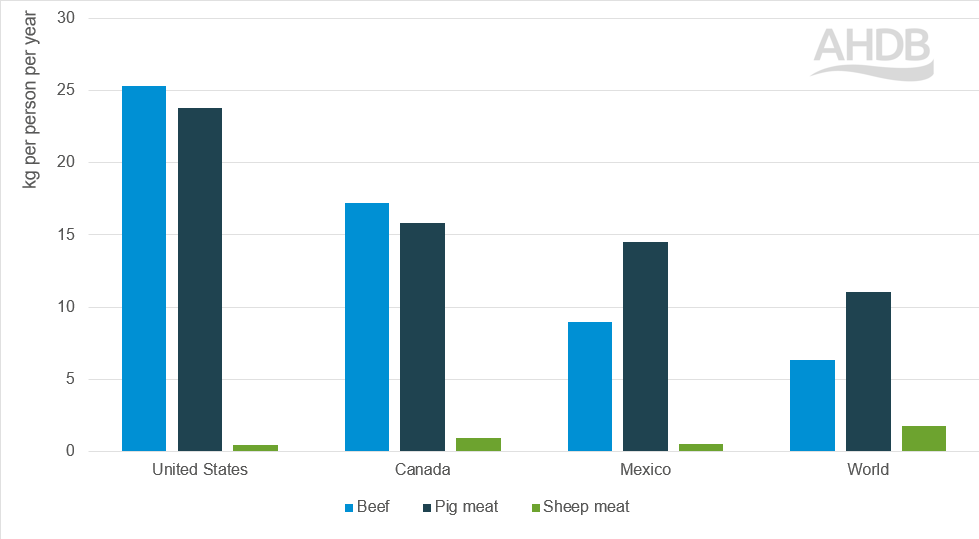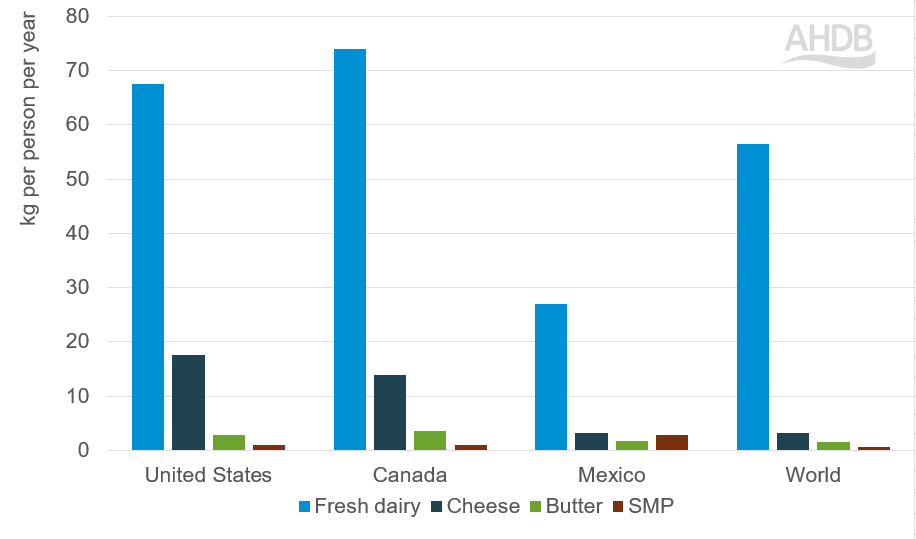- Home
- North America: How much do they consume?
North America: How much do they consume?
USA and Canada are developed markets, with high levels of meat and dairy consumption. Consumption is lower per capita in Mexico. However, demand is projected to rise as the economy strengthens and the middle class grows.
Figure 1. Red meat consumption per capita (2022)

Beef
Per capita consumption of beef is high, particularly in the USA and Canada (Figure 1). Growth in consumption is expected to be much lower than global averages. Total consumption across North America is expected to grow modestly from around 15m tonnes over the next ten years – a rate of 0.3% per year (Source: OECD) by 455,000 tonnes. The growth rate is slightly higher in Canada and Mexico (0.5% per year), compared to the USA (0.2%).
The USA is a significant beef producer and exporter. In the short-term, the US Department of Agriculture (USDA) expect domestic supplies to drop back (by 5.6% in 2023) as farmers rebuild stocks following widespread drought in 2022. Over the long-term, domestic beef production is expanding across all of the region and imports of beef are expected to only see marginal growth. Rather than relying on growth in volume of domestic consumption, the main opportunity for UK exports will be to provide products which are differentiated from conventional domestic production, particularly in the USA and Canada. Grass-fed, organic, antibiotic-free and hormone-free beef are all premium products where growth is likely.
Pork
Per capita consumption of pork is relatively high across North America; in Mexico it is higher than beef. Total consumption across North America is expected to grow from around 13m tonnes, by 1.25m tonnes over the next ten years, a rate of 0.9% a year (Source: OECD).
Opportunities for UK exporters may arise from the growing demand from Mexico, which is experiencing the most rapid growth in consumption. To meet this demand the OECD expect Mexican imports to rise by around a third (an extra 326,000 tonnes) over ten years.
In contrast, Canada and USA pork imports are expected to grow more modestly (110,000 tonnes). As with beef, the main opportunities for UK exports here will be in premium products, such as outdoor bred, organic and hormone-free.
Lamb
In contrast to the other proteins, lamb consumption is much lower in North America than the global average (0.6 kg per capita vs 1.9 kg). Lamb is a niche and unfamiliar protein to most consumers. Total consumption is expected to grow by 15,000 tonnes over the next ten years, a rate of 0.4% per year (OECD).
With low domestic production, the USA is the second-largest importer of sheep meat in the world. They import an average of around 140,000 tonnes (2019‒2021): Australia (80%) and New Zealand (20%) account for most imports. Imports from these two countries represent more than half the total US consumption and tend to be in the form of premium cuts, especially legs. Levels of domestic production and import levels are expected to remain broadly unchanged according to OECD.
The USA and Canada may become a market for high-value lamb cuts for some UK exporters. Demand is concentrated around Easter and other religious festivals. There are pockets of high consumption in the north east of the USA and in neighbouring Ontario, Canada. These areas have high concentrations of Middle Eastern, Caribbean and African consumers, making them a major market for lamb products. According to USDA, the typical lamb consumer is an older individual, of an ethnic-minority, who lives in a metropolitan area and who prefers to eat high-value lamb cuts like chops and leg.
Dairy
Consumption of fresh dairy products (like milk and cream) are high in the USA and Canada, but more limited in Mexico (Figure 2).
The USA and Canada also have high levels of cheese and butter consumption. In Mexico, skimmed milk powder (SMP) consumption is well above the global average.
Figure 2. Dairy consumption per capita (2019–2021 average)

Source: OECD
Cheese
Across North America, cheese consumption is growing more rapidly than other dairy categories in terms of total volume, at a rate of 1.5% per year (Source: OECD). If the growth continues, over 1m tonnes of extra cheese will be consumed per year in 10 years’ time, with 80% in the USA alone. This should result in opportunities for UK exporters. Although, it should be noted that domestic production of cheese has expanded in the USA and Canada, and this growth is projected to continue (Source: OECD).
UK product will need to be price-competitive or differentiated from domestic product to succeed in these markets. For instance, in Canada demand for dairy products that are ethically sourced and organic will outstrip the general growth in the market (Source: Euromonitor International). There are opportunities in Canada for British exporters to demonstrate the UK’s high welfare and sustainable farming standards.
Butter
Butter consumption is expected to grow across the region to 1.5m tonnes by 2031 (Source: OECD), with growth at similar rates around 1% per year in all three countries. Again, domestic production is growing and is projected to meet the bulk of demand. A small increase in import volumes is expected, reaching 103,000 tonnes annually in total.
Skimmed milk powder (SMP)
Nearly all SMP imports into North America are to Mexico, which has only limited domestic production. Here consumption is growing modestly and will reach 418,000 tonnes by 2031 (Source: OECD). SMP is a commodity product. We do not see opportunities for UK exporters given competition from big SMP exporters, such as the USA.
Continue reading about the North American market
Market access and barriers to trade

